JCET Group Bundle
Who are JCET Group's Key Customers in the Semiconductor Arena?
In the fast-paced world of semiconductors, understanding your customer is paramount. For JCET Group, a global leader in IC manufacturing services, pinpointing its customer demographics and target market is essential for strategic success. This analysis dives deep into JCET Group's customer profile, exploring their geographical distribution, specific needs, and the company's strategies for customer acquisition and retention.
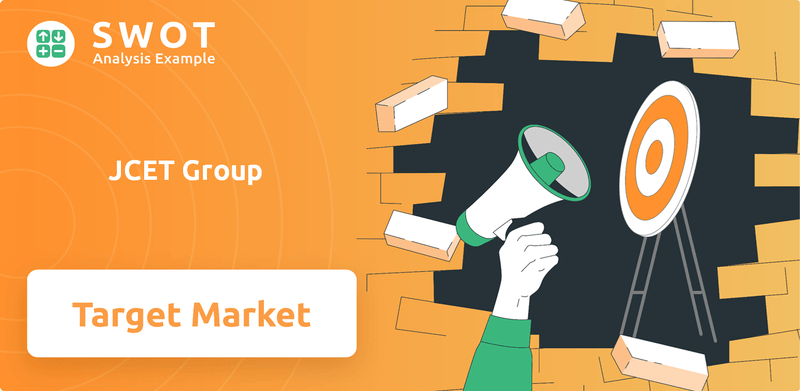
The JCET Group SWOT Analysis highlights the importance of understanding the market. As the semiconductor industry evolves, JCET Group’s ability to adapt to shifting customer needs, driven by technological advancements and global market dynamics, is crucial. This exploration provides a comprehensive market analysis, examining the company's customer segmentation and the competitive landscape to determine how JCET Group can maintain its market share.
Who Are JCET Group’s Main Customers?
Understanding the customer demographics and target market of JCET Group is crucial for grasping its position within the semiconductor industry. JCET Group operates primarily in a Business-to-Business (B2B) model, focusing on clients within the global semiconductor ecosystem. This approach defines its primary customer segments, which are key to its strategic direction and market performance.
The core of JCET Group's customer base consists of large, multinational technology corporations. These companies demand high-volume production, advanced packaging technologies, and stringent quality control. Their decision-making processes are heavily influenced by factors such as cost-effectiveness, turnaround time, technological capabilities, reliability, and supply chain security. A deep dive into the Marketing Strategy of JCET Group reveals how these aspects are central to its customer engagement.
The fastest-growing segment for JCET Group is likely companies involved in emerging technologies such as artificial intelligence, 5G communications, automotive electronics, and high-performance computing. These sectors require increasingly sophisticated and compact packaging solutions. For instance, the automotive semiconductor market is projected to reach an estimated $80.2 billion by 2029, a trend that directly impacts JCET's target segments.
JCET Group's customer base is segmented into integrated device manufacturers (IDMs), fabless semiconductor companies, and original equipment manufacturers (OEMs). These segments are defined by their roles in the semiconductor value chain and their specific needs regarding packaging and testing services.
The primary customer demographics include large multinational technology corporations. These companies typically have significant production volumes and require advanced technological capabilities. Their focus is on cost-effectiveness, reliability, and supply chain security.
JCET Group is increasingly focused on higher-value-added packaging and testing services, driven by the growing demand for advanced solutions. This shift is in response to the increasing complexity of IC designs and the need for miniaturization. The global outsourced semiconductor assembly and test (OSAT) market is anticipated to reach approximately $56.9 billion by 2029.
Emerging technologies such as artificial intelligence, 5G communications, automotive electronics, and high-performance computing represent the fastest-growing segments for JCET. These sectors drive the demand for advanced packaging solutions, influencing JCET's target market size and customer needs.
JCET Group’s strategic focus on advanced packaging and testing services is driven by market trends and customer needs. This strategic shift is crucial for maintaining a competitive edge and meeting the evolving demands of its sophisticated client base. This also influences JCET Group customer acquisition strategies.
- Focus on high-growth sectors like automotive electronics and AI.
- Emphasis on advanced packaging technologies to meet evolving customer needs.
- Strategic alignment with the projected growth of the OSAT market.
- Continuous investment in technological capabilities and supply chain security.
JCET Group SWOT Analysis
- Complete SWOT Breakdown
- Fully Customizable
- Editable in Excel & Word
- Professional Formatting
- Investor-Ready Format
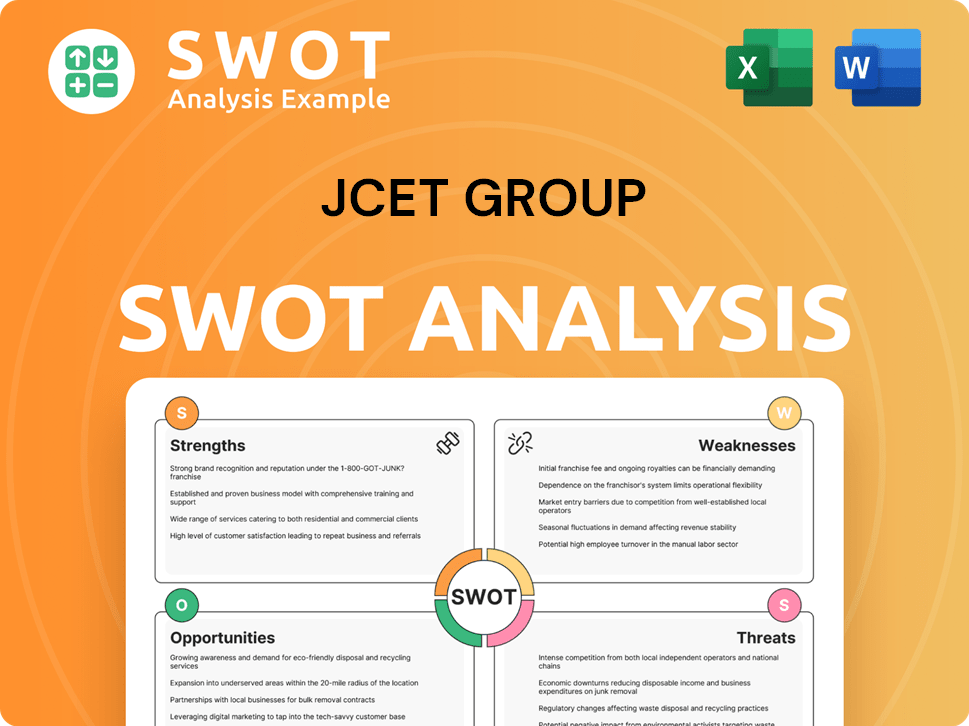
What Do JCET Group’s Customers Want?
Understanding the customer needs and preferences is crucial for the success of any business, and this is especially true for a company like JCET Group operating within the demanding semiconductor industry. The company's B2B customers, which include major electronics manufacturers and technology companies, have specific requirements that drive their purchasing decisions. These needs are primarily centered around technological capabilities, cost-effectiveness, and reliable supply chain management.
The target market for JCET Group is composed of businesses that require advanced packaging solutions for their products. These solutions are essential for creating smaller, more powerful, and energy-efficient devices. The semiconductor industry is constantly evolving, with the demand for advanced packaging solutions projected to grow significantly in the coming years, indicating the importance of understanding and meeting the needs of JCET Group's customer base.
The primary drivers for JCET Group's customers include the need for cutting-edge technology, reliable supply chains, and cost-effective solutions. They seek partners who can offer innovative packaging options like flip-chip and wafer-level packaging. The ability to handle high-volume production, adhere to strict industry standards, and provide efficient global logistics are also critical factors. Moreover, customers are motivated by the desire to achieve a competitive edge through innovative product designs.
Customers prioritize advanced packaging solutions like flip-chip and 3D integration. These technologies are vital for achieving higher performance and smaller form factors in end products. The focus is on innovations that enhance device capabilities.
Cost-effectiveness is a major consideration. Customers seek solutions that reduce overall production costs. This includes the ability to handle high-volume production with consistent quality.
Adherence to strict industry standards, particularly in automotive and industrial sectors, is critical. Customers require assurance that products meet stringent quality benchmarks. This ensures reliability and safety.
Customers depend on efficient global logistics and a reliable supply chain. This ensures timely delivery and minimizes disruptions. A robust supply chain is essential for meeting production schedules.
Speed to market is a key factor. Customers need solutions that enable them to launch products quickly. This involves efficient processes and rapid turnaround times.
Customers aim to gain a competitive advantage through innovative product designs. They seek partnerships with advanced providers. This drives innovation and market differentiation.
JCET Group's strategic approach involves addressing common customer pain points such as the escalating costs of in-house assembly and test, the need for specialized equipment, and the complexities of managing a global supply chain. The company actively invests in research and development to create next-generation packaging technologies, expands its global manufacturing footprint to provide localized support, and implements robust quality management systems. For example, JCET's focus on fan-out wafer-level packaging (FOWLP) and system-in-package (SiP) solutions directly addresses the industry's drive for greater integration and miniaturization, enabling their customers to develop more compact and powerful devices. To understand the company's history, you can read Brief History of JCET Group.
JCET Group's customers are primarily driven by technological capability, cost efficiency, and supply chain reliability. These factors are crucial for success in the competitive semiconductor industry. Meeting these needs requires continuous innovation and strategic investments.
- Advanced Packaging Solutions: Customers require cutting-edge packaging technologies like flip-chip, wafer-level packaging, and 3D integration to enhance product performance.
- Cost-Effective Production: Customers seek solutions that reduce overall costs and improve efficiency, including high-volume production capabilities.
- Quality and Reliability: Adherence to strict industry standards and robust quality management systems are essential for ensuring product reliability.
- Supply Chain Resilience: Efficient global logistics and a reliable supply chain are critical for timely delivery and minimizing disruptions.
- Innovation and Technology: Customers want to partner with companies that drive innovation and offer advanced solutions to stay ahead of the competition.
JCET Group PESTLE Analysis
- Covers All 6 PESTLE Categories
- No Research Needed – Save Hours of Work
- Built by Experts, Trusted by Consultants
- Instant Download, Ready to Use
- 100% Editable, Fully Customizable
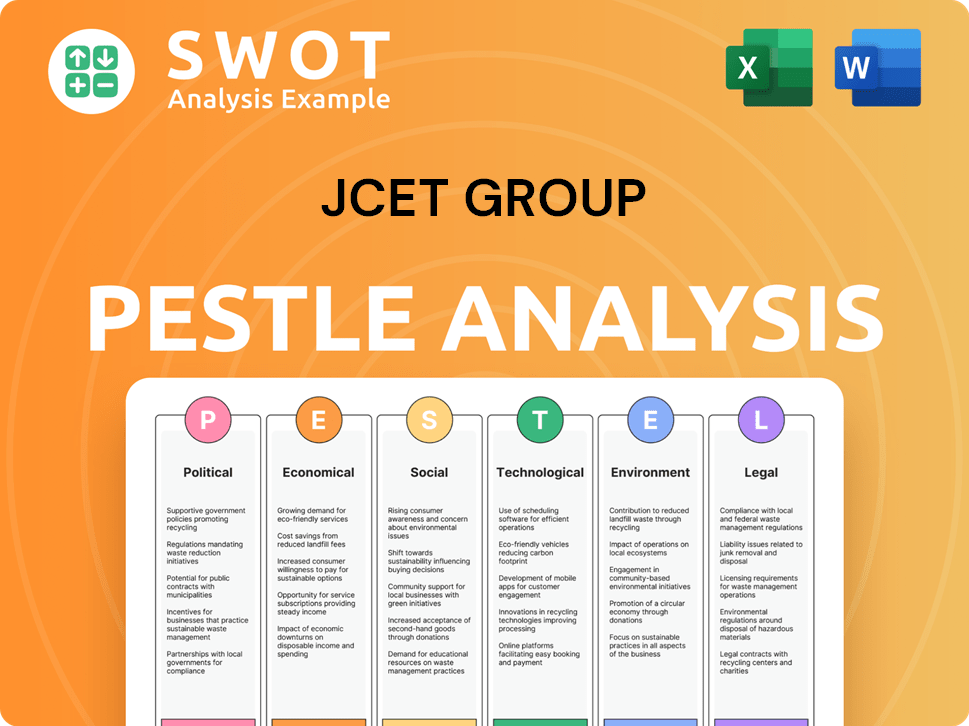
Where does JCET Group operate?
The geographical market presence of JCET Group is extensive, strategically serving a global customer base. Key markets include Asia, North America, and Europe, reflecting the worldwide distribution of integrated device manufacturers (IDMs), fabless semiconductor companies, and original equipment manufacturers (OEMs). This widespread reach is crucial for understanding the company's customer demographics and target market.
JCET Group's strong presence in Asia, particularly in China and Southeast Asia, is notable, given its origins and the concentration of semiconductor manufacturing and design hubs in the region. These areas are key operational centers and significant revenue contributors. The company's ability to adapt to regional market nuances is key to its success. This global strategy is essential for effective market analysis.
Differences in customer preferences and buying power exist across regions, influencing the specific industry verticals served and technological demands. For example, while North American and European customers may prioritize advanced packaging solutions, Asian customers also have significant demand for cost-effective solutions. This requires effective customer segmentation strategies.
JCET Group establishes manufacturing facilities and customer support centers in key regions. This localization strategy allows for closer collaboration with clients and reduces lead times. It also helps the company better understand regional market nuances and regulatory requirements, which is crucial for their customer acquisition strategies.
Recent investments have focused on enhancing advanced packaging capabilities globally. The company continues to expand its production capacity in strategic locations to meet the growing demand for advanced packaging technologies. This expansion is vital for capturing a larger target market size.
The global semiconductor packaging market is projected to reach $87.9 billion by 2029. This growth is driven by the increasing need for advanced packaging solutions in various end-use industries. This highlights the importance of JCET Group's global footprint and its ability to meet customer needs.
The geographic distribution of sales indicates a balanced approach, with significant revenue streams from both established and emerging semiconductor markets. This reflects JCET Group's commitment to diversified global growth and its ability to manage its customer relationship management effectively.
JCET Group faces competition from other major players in the semiconductor packaging market. Understanding the competitive landscape is crucial for maintaining and increasing its market share. For more insights, see Growth Strategy of JCET Group.
Analyzing the JCET Group target audience analysis reveals a diverse customer base. This includes IDMs, fabless companies, and OEMs across various industries. Understanding the JCET Group customer profile is key to tailoring offerings.
The JCET Group customer base breakdown shows a mix of large and small clients. The company serves various sectors, including consumer electronics, automotive, and high-performance computing. This diversification helps mitigate risks and ensures sustained growth.
JCET Group's ideal customer characteristics include companies seeking advanced packaging solutions, reliable service, and global support. These customers value innovation and cost-effectiveness. Identifying these characteristics helps refine how to reach JCET Group's target market.
JCET Group Business Model Canvas
- Complete 9-Block Business Model Canvas
- Effortlessly Communicate Your Business Strategy
- Investor-Ready BMC Format
- 100% Editable and Customizable
- Clear and Structured Layout
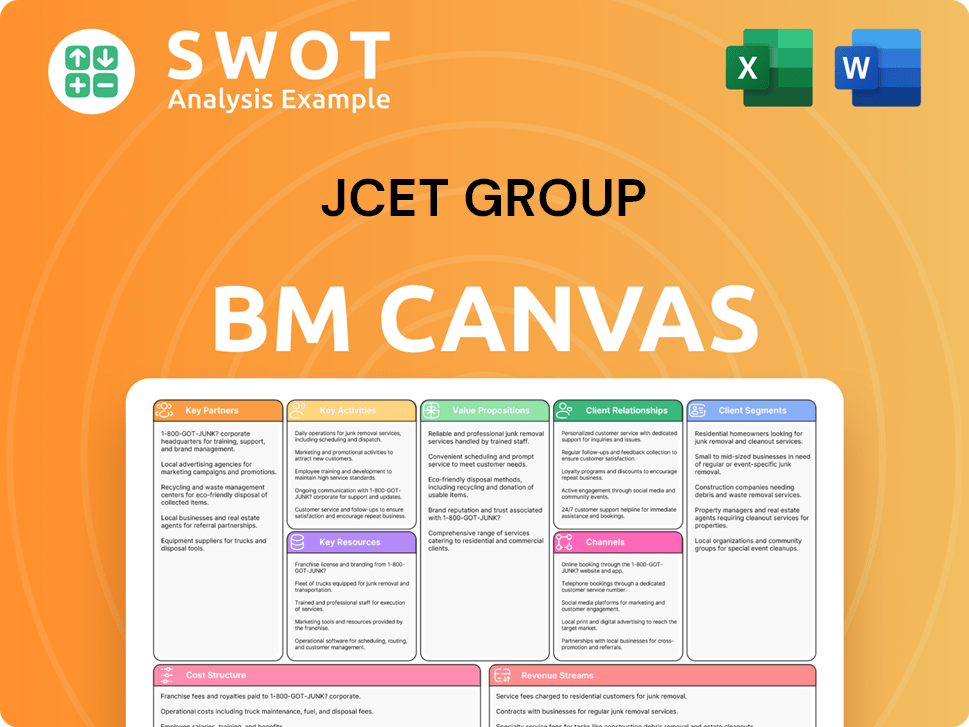
How Does JCET Group Win & Keep Customers?
The company, a major player in the semiconductor industry, employs a multifaceted strategy for acquiring and retaining customers. Their approach is built upon technological expertise, a global presence, and strong customer relationships. This strategy is crucial in a market where precision and reliability are paramount.
Customer acquisition focuses on direct sales, industry events, and strategic partnerships. Digital marketing supports brand building, while referrals often come through positive word-of-mouth within the closely-knit semiconductor community. The company's sales tactics emphasize comprehensive solutions, highlighting advanced packaging capabilities as key differentiators.
Retention strategies prioritize high-quality service, reliable delivery, competitive pricing, and collaborative problem-solving. Personalized experiences are provided through dedicated account managers, and after-sales service includes technical support and continuous improvement initiatives. The outsourced semiconductor assembly and test (OSAT) market is projected to reach $56.9 billion by 2029, underscoring the dynamic environment influencing these strategies.
The company primarily acquires customers through direct sales engagements and strategic partnerships with leading integrated device manufacturers (IDMs) and fabless companies. Participation in industry events like SEMICON and CES is also a key acquisition method. These methods are crucial in the B2B semiconductor space.
While direct B2B sales are the primary focus, digital marketing supports brand building and thought leadership. This includes corporate websites, industry publications, and professional networking platforms like LinkedIn. This helps in reaching the target audience.
Sales tactics emphasize offering comprehensive turnkey solutions, from package design to drop shipment. Showcasing advanced packaging capabilities, such as fan-out and 3D integration, is a key differentiator. This approach caters to the complex needs of the semiconductor industry.
Customer data and CRM systems are crucial for segmenting clients based on technology requirements and market segments. This segmentation informs targeted campaigns for new technologies or capacity expansions. This helps tailor solutions to meet specific customer needs.
The company's approach to customer acquisition and retention is deeply intertwined with understanding its customer demographics and target market. Effective strategies include leveraging a strong global presence and fostering collaborative relationships. For a deeper understanding of the company's revenue streams and business model, you can refer to this article: Revenue Streams & Business Model of JCET Group.
Direct sales engagements, industry events, and strategic partnerships are the primary acquisition methods. Digital marketing is used for brand building. Referral programs also play a role in customer acquisition.
The focus is on providing comprehensive turnkey solutions, from design to shipment. They highlight advanced packaging capabilities. This ensures a competitive edge in the market.
Retention is driven by high-quality service, reliable delivery, and competitive pricing. Personalized experiences are provided through dedicated account managers. After-sales service includes technical support.
Customer data and CRM systems are used to segment clients based on their needs. This data informs targeted campaigns. This ensures that the company can meet specific customer requirements.
The OSAT market, in which the company operates, is projected to reach $56.9 billion by 2029. This underscores the dynamic environment influencing the company's strategies. This growth reflects the importance of their services.
Innovative retention initiatives include joint development programs with key customers. The company focuses on co-creating next-generation packaging solutions. This collaborative approach drives customer loyalty.
JCET Group Porter's Five Forces Analysis
- Covers All 5 Competitive Forces in Detail
- Structured for Consultants, Students, and Founders
- 100% Editable in Microsoft Word & Excel
- Instant Digital Download – Use Immediately
- Compatible with Mac & PC – Fully Unlocked
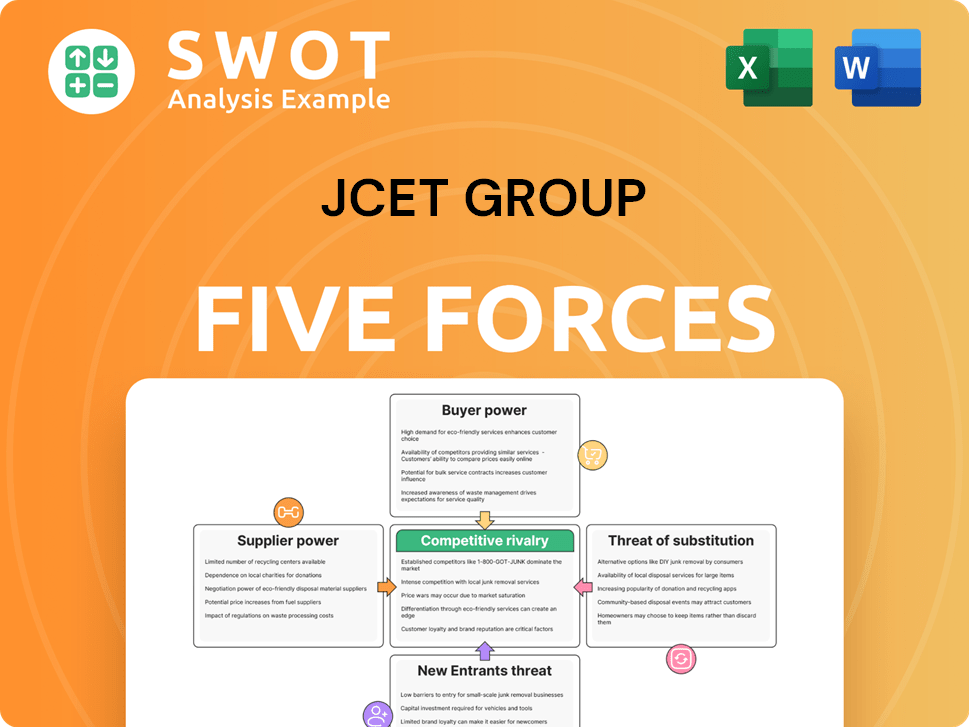
Related Blogs
- What are Mission Vision & Core Values of JCET Group Company?
- What is Competitive Landscape of JCET Group Company?
- What is Growth Strategy and Future Prospects of JCET Group Company?
- How Does JCET Group Company Work?
- What is Sales and Marketing Strategy of JCET Group Company?
- What is Brief History of JCET Group Company?
- Who Owns JCET Group Company?
Disclaimer
All information, articles, and product details provided on this website are for general informational and educational purposes only. We do not claim any ownership over, nor do we intend to infringe upon, any trademarks, copyrights, logos, brand names, or other intellectual property mentioned or depicted on this site. Such intellectual property remains the property of its respective owners, and any references here are made solely for identification or informational purposes, without implying any affiliation, endorsement, or partnership.
We make no representations or warranties, express or implied, regarding the accuracy, completeness, or suitability of any content or products presented. Nothing on this website should be construed as legal, tax, investment, financial, medical, or other professional advice. In addition, no part of this site—including articles or product references—constitutes a solicitation, recommendation, endorsement, advertisement, or offer to buy or sell any securities, franchises, or other financial instruments, particularly in jurisdictions where such activity would be unlawful.
All content is of a general nature and may not address the specific circumstances of any individual or entity. It is not a substitute for professional advice or services. Any actions you take based on the information provided here are strictly at your own risk. You accept full responsibility for any decisions or outcomes arising from your use of this website and agree to release us from any liability in connection with your use of, or reliance upon, the content or products found herein.